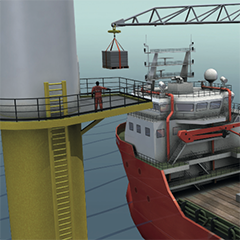The rapid market expansion, in offshore generated wind power, requires a new approach towards offshore access for maintenance of wind generators. Two experts in access systems, Willem Prins and Marco Klitsie, developed a totally new and patented access method for which solid investors and building partners have already been found. The EAGLE-ACCESS SYSTEM will be ready for trials in early 2019 and so PES wanted to know more…
Background
Looking back on 15 years of experience in consultancy and the design and development of access systems for offshore platforms for several clients in the market, we conclude the present technology is far from mature. There are still more technical steps to be made, especially in the offshore wind market.
A short history
By the end of the 20th century the offshore oil and gas industry felt the need for cheaper access for personnel to platforms, replacing the expensive use of helicopters, which was also driven by the trend towards smaller and unmanned platforms.
In 2003 the first proposals for access from PSV’s to platforms came to light and two competing access systems were introduced to the market: OAS by Offshore Solutions and Ampelmann. Both systems accommodated the access for personnel from DPII supply vessels to oil and gas platforms, mainly in the North Sea area, a limited market at the time.
In the same period and also in the North Sea, investments in offshore wind parks started, driven by the upcoming alternatives for oil and gas as primary energy sources: wind power. The building of wind generator parks requires the same type of access to the foundation piles for personnel as the oil and gas platforms. So the access systems originally developed for the oil and gas market, could service the building of wind parks just as well. And they did.
Wind energy has been booming ever since and many players have entered the market with modernised variants of the early access systems. These bring people from vessels to platforms and vice versa, in batches of small groups and/or on a 24/7 basis.
It is remarkable to see that the present access systems and operators technically all follow in each other’s footsteps, by offering the nowadays well known bridge type access for people. The Walk To Work system. They look alike and work similarly. Apart from the extra towers and lifts to fulfil the requirement for more safety, comfort and higher access: only adding to their weight, power consumption and complexity.
But over the last 15 years the market requirements have changed. In its early days the market for access systems was technology driven. Operators had to use whatever the suppliers were offering. Even now the operators in the market basically do not offer much more than safe transfer for people only. Cargo is problematic and present access systems are still heavy, complex and large. They operate at relatively high cost in limited conditions.





























